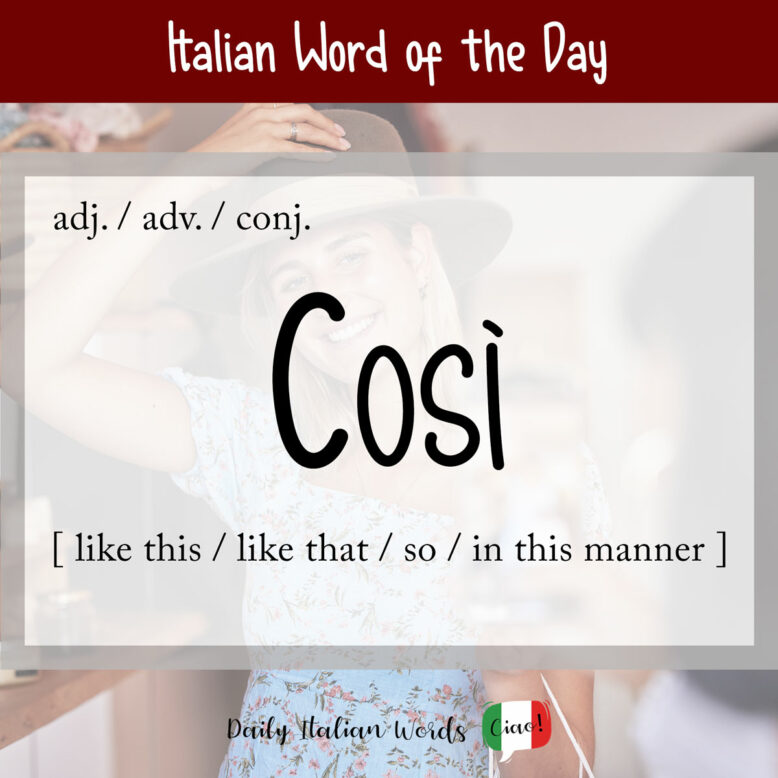Così is one of those amazingly versatile words in the Italian language with various meanings based on the context it’s used in. It serves not only as an adverb but also as a conjunction and an adjective, making it quite challenging to summarise in a single article. Nonetheless, let’s give it a shot!
Before we begin, it is important to note that così is written with an accented ì, meaning that emphasis is placed on the final syllable rather than the first. You can listen to the correct pronunciation below.
così

Così: The Adverb
Così is commonly used as an adverb, covering the following meanings. Regardless of the translation you opt for, this version of così always indicates the manner in which something is done.
- like this / that
- this is / that is how
- as follows
- that
- in this / that way
- in this / that manner
- this is / that is what
Let’s look at a few example sentences to see how it is used in context.
Il cassetto si apre così.
The drawer opens like this / in this way.
Per cucinare la pasta bisogna fare così.
You cook the pasta as follows. / This is how you cook the pasta.
Così finisce il libro.
This / That is how the book ends.
No, non ho detto così.
No, that’s not what I said.

Così can also be placed after an adjective or adverb in order to make reference to the size or dimension of something.
La pozzanghera era grande così!
The puddle was this big!
Likewise, it can add emphasis, much like the words extremely or very much. In this case, the best translation is usually so or so much.
Ti ama così tanto. Sei molto fortunata.
He loves you so much. You’re very lucky.
Sembrava così gentile ed educato. Come ho potuto sbagliarmi così?
He seemed so kind and polite. How could I have been so wrong?
Finally così, as an adverb, can mean so as in the same thing or likewise.
Monica l’ha salutato e così ho fatto anch’io.
Monica said hello to him and so did I.
Così: The Conjunction
There are a couple of patterns you are bound to come across in which così is used as a conjunction:
- così…che = so…that
- così…da = so…as / enough
Era così alto che toccava il soffitto con la testa.
He was so tall that his head touched the ceiling.
Perché sei stato così stupido da rischiare la vita?
Why were you stupid enough / so stupid as to risk your life?

You can also expect to hear the conjunction così used to mean so, with the meaning therefore, or well then when placed at the beginning of a sentence after e (and).
Aveva la tosse, così non è andato a scuola.
He had a cough so he didn’t go to school.
E così? Hai deciso se vuoi unirti a noi?
Well then? Have you decided if you want to join us?
What’s more, così is a conjunction when it means that way or so that. This is easily one of the most common uses for così in everyday spoken Italian.
Mettiti la giacca, così non prendi freddo.
Put on your jacket, that way / so that you won’t get cold.
Before we move on to adjectives, let’s take a brief moment to look at così come, which in most cases, equates to as well as or (just) like/as in English.
Maria è così come la immaginavo.
Maria is just as I imagined.
Le tende possono essere utilizzate nei concerti, così come nei festival.
The tents can be used in concerts, as well as at festivals.
Così: The Adjective
Last but not least, we come to così as an adjective. When it modifies a noun, it almost always translates to such or like that as in the following examples:
Vorrei abitare in una casa così!
I’d like to live in a house like this!
Hai mai visto un posto così?
Have you ever seen such a place?

Before we conclude this article, let’s take a quick look at some set expressions featuring così that you will come across in everyday Italian.
- Basta così! = That’s enough!
- E così via. = And so on.
- Così (e) così. = So so.
- Meglio di così! = What more could you ask for!
- Per così dire = So to say
- È così. = That’s right. / That’s how it is.
- Così facendo = by doing so / this
- Così fosse! = If only that were the case!
- Così sia! = So be it!
- Così pare. = So it seems.
- Va bene così. = It’s ok / fine (like that).
- Così come stanno le cose = As things stand

Heather Broster is a graduate with honours in linguistics from the University of Western Ontario. She is an aspiring polyglot, proficient in English and Italian, as well as Japanese, Welsh, and French to varying degrees of fluency. Originally from Toronto, Heather has resided in various countries, notably Italy for a period of six years. Her primary focus lies in the fields of language acquisition, education, and bilingual instruction.


